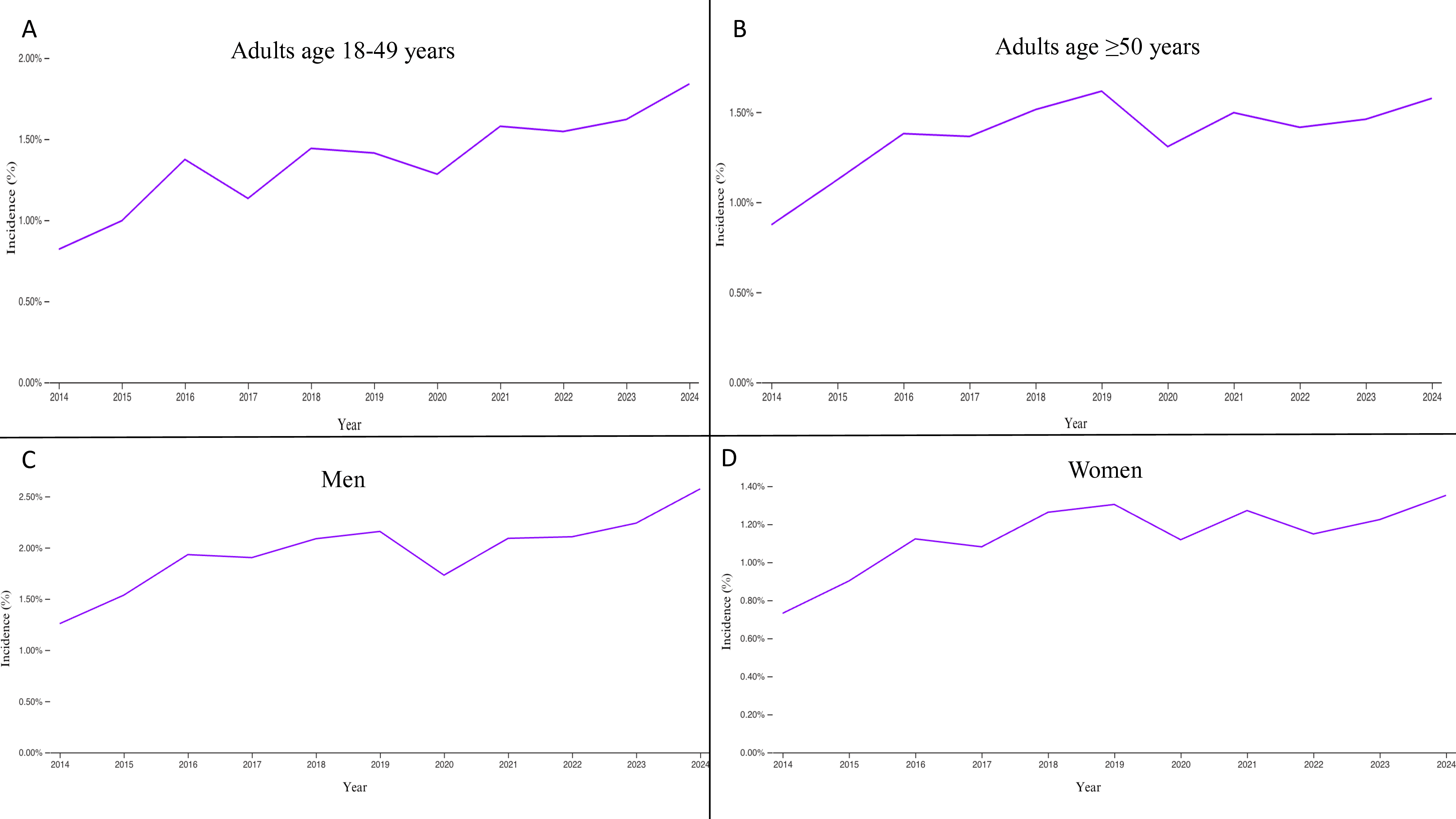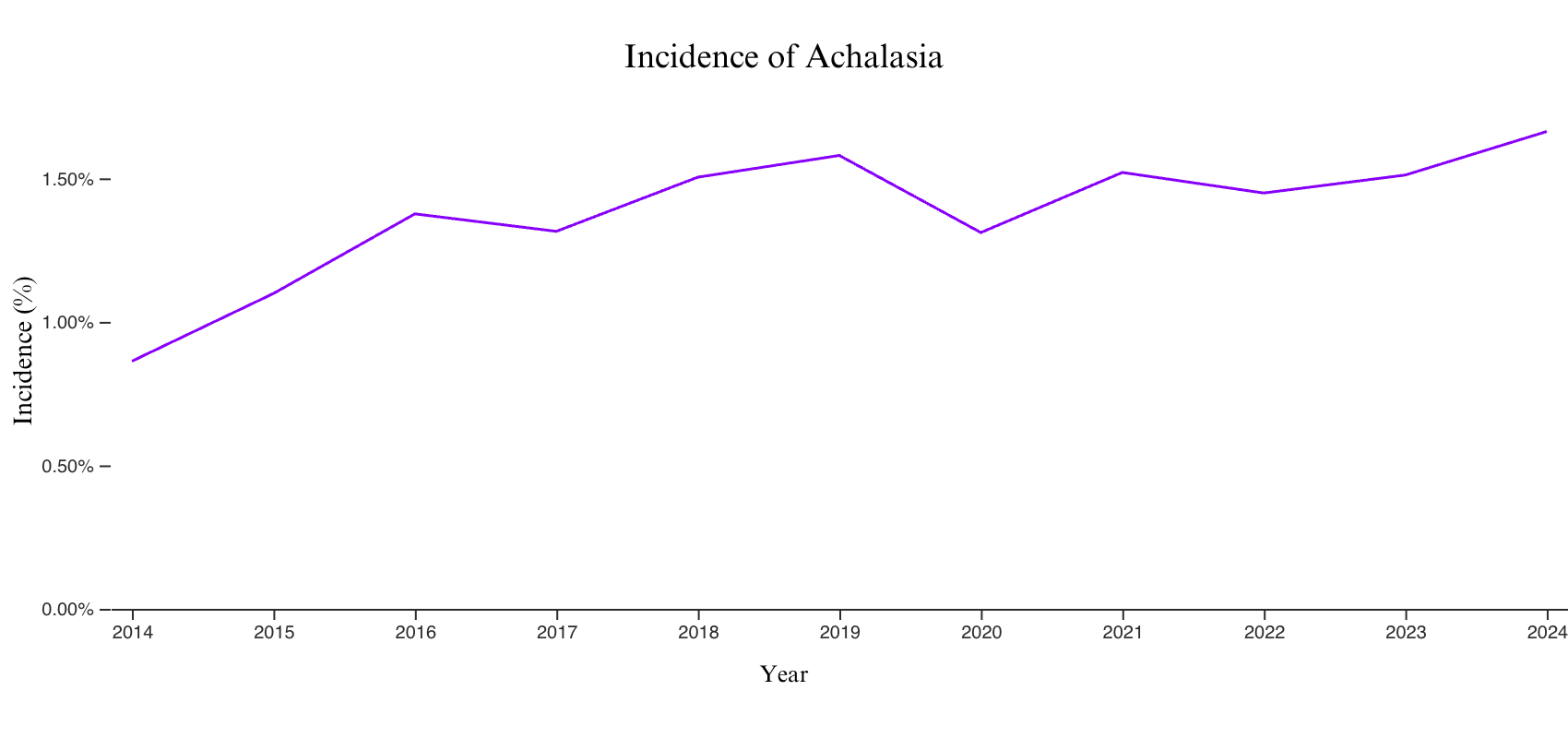Tuesday Poster Session
Category: Esophagus
P4878 - Increasing Incidence of Achalasia in the United States Between 2014-2024: A TriNetX Study
Tuesday, October 28, 2025
10:30 AM - 4:00 PM PDT
Location: Exhibit Hall
- AV
Anila Vasireddy, MD (she/her/hers)
University of Pennsylvania Health System
Philadelphia, PA
Presenting Author(s)
Anila Vasireddy, MD1, Ilora Naik, MD2, Nicha Wongjarupong, MD2, Lim Jane, MD2, Yin Chan, MD3, Bianca Chang, MD3, Mark Pimentel, MD, FACG2, Ali Rezaie, MD, MSc2, Apoorva K. Chandar, MBBS, MPH4, Amrit K. Kamboj, MD2
1University of Pennsylvania Health System, Philadelphia, PA; 2Cedars-Sinai Medical Center, Los Angeles, CA; 3Cedars-Sinai Medical Center, Beverly Hills, CA; 4Digestive Health Institute, University Hospitals Cleveland Medical Center, Cleveland, OH
Introduction: Achalasia is a rare esophageal motility disorder characterized by failed peristalsis and inadequate relaxation of the lower esophageal sphincter. Given the rarity of this condition, its epidemiology is not well defined, although a few studies in specific populations suggest that the incidence of achalasia is on the rise. The aim of this study was to examine the epidemiology of achalasia using a large national, population-based database.
Methods: Data on patients with achalasia was extracted from the TriNetX database, a composite of electronic health records from 66 healthcare organizations, between January 2014 and December 2024. Achalasia was defined using ICD-10 (K22.0) code and patients were required to have CPT code (91010 and 91013) for high-resolution esophageal manometry (HRM) prior to achalasia diagnosis. Data was extracted on patient demographics including age, sex, race, and ethnicity. Negative binomial regression was used to evaluate trends.
Results: A total of 17,377 patients were diagnosed with achalasia between 2014-2024 (mean age 57.6 ± 17.8 years, 52.3% women, and 64.4% White). The overall incidence of achalasia increased from 0.86% in 2014 to 1.66% in 2024 (Figure 1). The incidence of achalasia between 2014-2024 increased among all age groups (age 18-49 years, 0.82% to 1.84%; age ≥50 years, 0.87% to 1.58%) (Figure 2A-B) as well as in both men (1.26% to 2.57%) and women (0.73% to 1.35%) (Figure 2C-D). Furthermore, the incidence increased among all races [White (0.77% to 1.64%), African American (1.11% to 1.76%), and Asian (0.51% to 2.07%)] and ethnicities [Hispanic/Latino (0.86% to 1.81%) and Non-Hispanic/Latino (0.89% to 1.63%)] during the study period.
Discussion: In this large national, population-based study utilizing data from the TriNetX database, we demonstrate a 2-fold increase in incidence of achalasia in the United States over the past decade. The increase in incidence was seen both overall and among different subgroups including age, sex, race, and ethnicity. The increase in achalasia incidence may be, in part, due to advancements in HRM and adoption of better diagnostic criteria during the study period. However, additional studies are needed to better elucidate the factors contributing to the increase in achalasia diagnosis.

Figure: Incidence of Achalasia between 2014-2024

Figure: Figure 2A: Incidence of Achalasia among 18-49 years of age
Figure 2B: Incidence of Achalasia among ≥50 years
Figure 2C: Incidence of Achalasia among Men
Figure 2D: Incidence of Achalasia among Women
Disclosures:
Anila Vasireddy indicated no relevant financial relationships.
Ilora Naik indicated no relevant financial relationships.
Nicha Wongjarupong indicated no relevant financial relationships.
Lim Jane indicated no relevant financial relationships.
Yin Chan indicated no relevant financial relationships.
Bianca Chang indicated no relevant financial relationships.
Mark Pimentel: Ardelyx – Consultant. Gemelli Biotech – Advisory Committee/Board Member, Royalties, Stock-privately held company. GoodLFE – Stock-privately held company. Salvo Health, Cylinder Health – Stock Options.
Ali Rezaie: Ardelyx, Blueprint Medicine and Salix Pharmaceuticals – Consultant. Gemelli Biotech, and Good LFE – Equity stake.
Apoorva Chandar indicated no relevant financial relationships.
Amrit Kamboj: Sanofi – Speakers Bureau.
Anila Vasireddy, MD1, Ilora Naik, MD2, Nicha Wongjarupong, MD2, Lim Jane, MD2, Yin Chan, MD3, Bianca Chang, MD3, Mark Pimentel, MD, FACG2, Ali Rezaie, MD, MSc2, Apoorva K. Chandar, MBBS, MPH4, Amrit K. Kamboj, MD2. P4878 - Increasing Incidence of Achalasia in the United States Between 2014-2024: A TriNetX Study, ACG 2025 Annual Scientific Meeting Abstracts. Phoenix, AZ: American College of Gastroenterology.
1University of Pennsylvania Health System, Philadelphia, PA; 2Cedars-Sinai Medical Center, Los Angeles, CA; 3Cedars-Sinai Medical Center, Beverly Hills, CA; 4Digestive Health Institute, University Hospitals Cleveland Medical Center, Cleveland, OH
Introduction: Achalasia is a rare esophageal motility disorder characterized by failed peristalsis and inadequate relaxation of the lower esophageal sphincter. Given the rarity of this condition, its epidemiology is not well defined, although a few studies in specific populations suggest that the incidence of achalasia is on the rise. The aim of this study was to examine the epidemiology of achalasia using a large national, population-based database.
Methods: Data on patients with achalasia was extracted from the TriNetX database, a composite of electronic health records from 66 healthcare organizations, between January 2014 and December 2024. Achalasia was defined using ICD-10 (K22.0) code and patients were required to have CPT code (91010 and 91013) for high-resolution esophageal manometry (HRM) prior to achalasia diagnosis. Data was extracted on patient demographics including age, sex, race, and ethnicity. Negative binomial regression was used to evaluate trends.
Results: A total of 17,377 patients were diagnosed with achalasia between 2014-2024 (mean age 57.6 ± 17.8 years, 52.3% women, and 64.4% White). The overall incidence of achalasia increased from 0.86% in 2014 to 1.66% in 2024 (Figure 1). The incidence of achalasia between 2014-2024 increased among all age groups (age 18-49 years, 0.82% to 1.84%; age ≥50 years, 0.87% to 1.58%) (Figure 2A-B) as well as in both men (1.26% to 2.57%) and women (0.73% to 1.35%) (Figure 2C-D). Furthermore, the incidence increased among all races [White (0.77% to 1.64%), African American (1.11% to 1.76%), and Asian (0.51% to 2.07%)] and ethnicities [Hispanic/Latino (0.86% to 1.81%) and Non-Hispanic/Latino (0.89% to 1.63%)] during the study period.
Discussion: In this large national, population-based study utilizing data from the TriNetX database, we demonstrate a 2-fold increase in incidence of achalasia in the United States over the past decade. The increase in incidence was seen both overall and among different subgroups including age, sex, race, and ethnicity. The increase in achalasia incidence may be, in part, due to advancements in HRM and adoption of better diagnostic criteria during the study period. However, additional studies are needed to better elucidate the factors contributing to the increase in achalasia diagnosis.

Figure: Incidence of Achalasia between 2014-2024

Figure: Figure 2A: Incidence of Achalasia among 18-49 years of age
Figure 2B: Incidence of Achalasia among ≥50 years
Figure 2C: Incidence of Achalasia among Men
Figure 2D: Incidence of Achalasia among Women
Disclosures:
Anila Vasireddy indicated no relevant financial relationships.
Ilora Naik indicated no relevant financial relationships.
Nicha Wongjarupong indicated no relevant financial relationships.
Lim Jane indicated no relevant financial relationships.
Yin Chan indicated no relevant financial relationships.
Bianca Chang indicated no relevant financial relationships.
Mark Pimentel: Ardelyx – Consultant. Gemelli Biotech – Advisory Committee/Board Member, Royalties, Stock-privately held company. GoodLFE – Stock-privately held company. Salvo Health, Cylinder Health – Stock Options.
Ali Rezaie: Ardelyx, Blueprint Medicine and Salix Pharmaceuticals – Consultant. Gemelli Biotech, and Good LFE – Equity stake.
Apoorva Chandar indicated no relevant financial relationships.
Amrit Kamboj: Sanofi – Speakers Bureau.
Anila Vasireddy, MD1, Ilora Naik, MD2, Nicha Wongjarupong, MD2, Lim Jane, MD2, Yin Chan, MD3, Bianca Chang, MD3, Mark Pimentel, MD, FACG2, Ali Rezaie, MD, MSc2, Apoorva K. Chandar, MBBS, MPH4, Amrit K. Kamboj, MD2. P4878 - Increasing Incidence of Achalasia in the United States Between 2014-2024: A TriNetX Study, ACG 2025 Annual Scientific Meeting Abstracts. Phoenix, AZ: American College of Gastroenterology.
